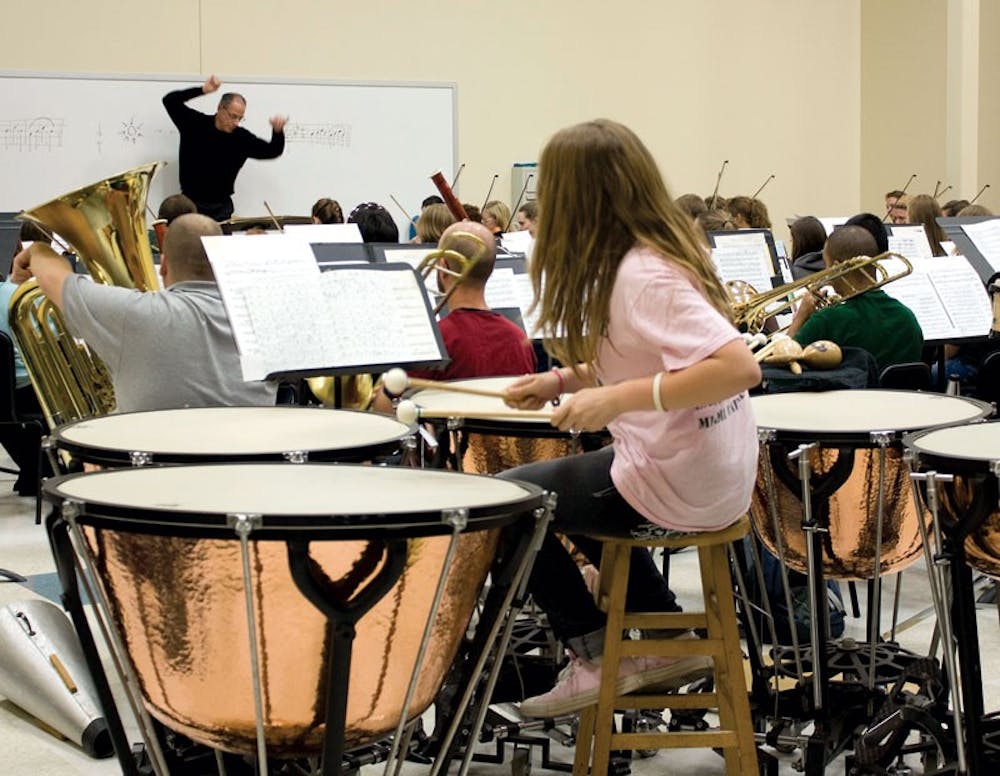Miami University's Symphony Orchestra performed the first concert of its 101st season on Friday, October 6. The concert, titled "The Symphony of the Dance," featured a diverse program of music, with all the pieces centered around the theme of fighting for freedom. This year's theme comes from the concert's dedication to Daniel Pearl's World Music Days.
Daniel\0x200B \0x200BPearl\0x200B \0x200Bwas\0x200B \0x200Ban\0x200B \0x200BAmerican\0x200B \0x200Bjournalist\0x200B \0x200Bfor\0x200B \0x200Bthe\0x200B \0x200BWall\0x200B \0x200BStreet\0x200B \0x200BJournal\0x200B \0x200Bwho\0x200B \0x200Bwas murdered\0x200B \0x200Bby\0x200B \0x200Bterrorists\0x200B \0x200Bwhile\0x200B \0x200Bon\0x200B \0x200Bassignment\0x200B \0x200Bin\0x200B \0x200BPakistan\0x200B \0x200Bin\0x200B \0x200B2002.\0x200B \0x200BIn response to the tragedy, his family and friends created World\0x200B \0x200BMusic\0x200B \0x200BDays, an annual\0x200B \0x200Bseries\0x200B \0x200Bof\0x200B \0x200Borchestral\0x200B \0x200Bconcerts\0x200B, as a way to spread cross-cultural understanding and peace. Held every year in October, the event draws participation from over 140 countries. Miami's\0x200B \0x200BSymphony\0x200B \0x200BOrchestra\0x200B \0x200Bhas\0x200B \0x200Bbeen\0x200B \0x200Bparticipating\0x200B\0x200B \0x200Bsince\0x200B \0x200B2009.
Conductor Ricardo Averbach, who's been with the orchestra for all of their performances in World Music Days, said he wanted the concert to connect with the events happening throughout the world today.
\0x200B"I chose the pieces to demonstrate\0x200B \0x200Bunity\0x200B \0x200Band\0x200B \0x200Bcoherence\0x200B \0x200Bout\0x200B \0x200Bof\0x200B \0x200Bapparently\0x200B \0x200Bcontradictory elements," said Averbach. "These things make our concerts more meaningful than just one more concert of the university orchestra. We make connections of the repertoire with our own history and with what is happening in the world."
Beginning with the loud bang of a gong, the concert was high energy from the very start.
The opening piece, Aaron Copland's "Fanfare for the Common Man," performed by an ensemble of brass players and percussionists from the orchestra, set the tone for the night with its strong, military-esque sound. The ensemble then performed a more modern piece, Anthony DiLorenzo's "Luminosity," while still keeping with the high-energy tone of the first.
Following the brass and percussion ensemble, the orchestra's guests for the evening, the Peraza Music Workshop Ensemble, came to the stage to perform "Salut D'Amour" by Edward Elgar. \0x200BCreated\0x200B \0x200Bin\0x200B \0x200B2005,\0x200B \0x200Bthe Workshop \0x200Bhas\0x200B \0x200Bbecome\0x200B \0x200Bone of\0x200B \0x200Bthe\0x200B \0x200Bmost\0x200B \0x200Bnotable\0x200B \0x200Bmusic\0x200B \0x200Bstudios\0x200B \0x200Bin\0x200B \0x200Bthe\0x200B \0x200Btri-county\0x200B \0x200Barea, with students going on to study music at prestigious institutions such as The Juilliard School.
The students in the ensemble were middle and high school students from the Cincinnati area playing violins, violas and cellos, joined by their teacher and founder of the group, Marion Peraza. \0x200BThe piece was in stark contrast to the high energy pieces performed by the brass and percussion ensemble, changing the mood with its relaxed and gorgeous string melodies.
Professor Cole Tutino performed along with the orchestra next, playing Joachim Raff's "Concerto No. 1 for Cello and Orchestra." This piece of music was virtually forgotten after the composer's death in 1882, and was only recently re-discovered and recorded by musicians. Professor Tutino came across the piece over the summer while researching possible concertos to perform with the orchestra.
Sitting on a raised platform in front of the orchestra, Tutino captivated the audience with his virtuosic playing. Audience and orchestra members alike couldn't help but crack a smile while watching the expressiveness on Tutino's face as he became fully engaged in his music. His performance earned a standing ovation and very long applause from the audience.
His performance marked the first time the piece has been played in Ohio, and was among only a handful of performances of the piece in the United States.
"I\0x200B \0x200Bthought\0x200B \0x200Bit\0x200B \0x200Bwould\0x200B \0x200Bbe\0x200B \0x200Ba\0x200B \0x200Bgood idea\0x200B \0x200Bto\0x200B \0x200Btake\0x200B \0x200Bthis\0x200B \0x200Bforgotten\0x200B \0x200Bpiece\0x200B \0x200Band\0x200B \0x200Breintroduce\0x200B \0x200Bit\0x200B \0x200Bto\0x200B \0x200Baudiences," Tutino said.
Enjoy what you're reading?
Signup for our newsletter
The concert concluded with the featured piece, Beethoven's "Symphony No. 7," one of the most famous and influential pieces of classical music.\0x200B This is the first piece professor Averbach performed with the orchestra when he began in 2002. After performing Beethoven's third symphony with the orchestra at its centennial concert last year, Averbach had conducted all nine of Beethoven's symphonies, and began the cycle again with what he claims to be his personal favorite.
Conducting from memory, Averbach emoted energy and passion with his expressive motions, keeping the audience and orchestra on their toes throughout the 40-minute piece. Once again, the audience rose to its feet to give a standing ovation to the orchestra as they finished their concert.
ander198@miamioh.edu
Updated Oct. 10, 2017




